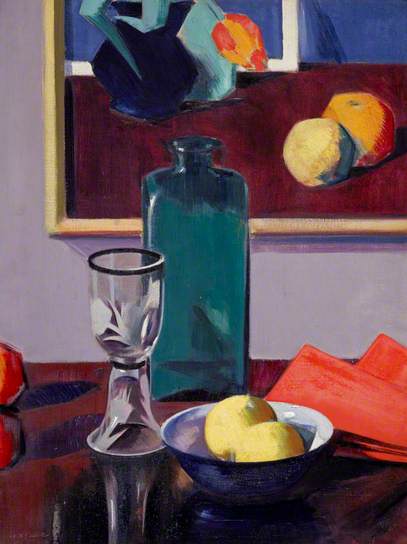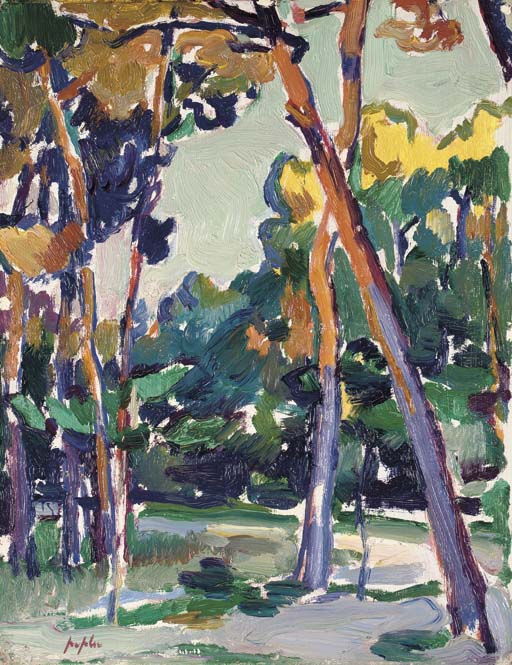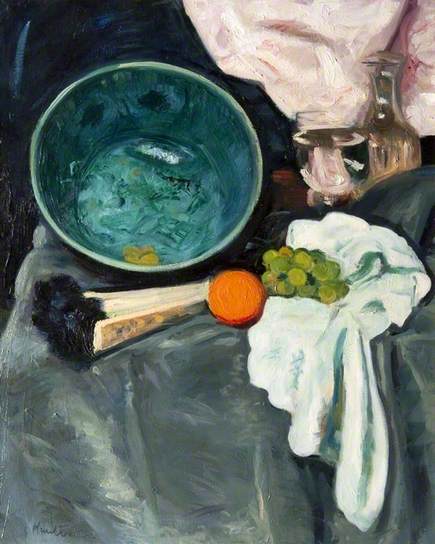Fergusson Artist Biography
Fergusson was born 9 March 1874 at 7 Crown Street in the port of Leith, north of Edinburgh, the son of John and Christina Fergusson. In later years Ferguson maintained that he had enrolled at the University of Edinburgh to study Medicine, but there is no surviving record of his matriculation. In c. 1893 Fergusson enrolled at the Trustees’ Academy in Edinburgh; however he was frustrated by the institution’s syllabus and his studies were therefore of short duration. Fergusson was largely self-taught aside from various brief periods of study at several Paris ateliers and studios. During the 1890s Fergusson produced a series of small-scale rapidly executed park and street scenes painted in and around Edinburgh. To facilitate the process of capturing spontaneous outdoor scenes, Fergusson devised a small painting box with interior grooves to hold small boards on which to paint, with the lid serving as a palette. Several of these impulsive studies recently passed through Lyon and Turnbull, including The Forth near Edinburgh, Evening and Landscape, Aberdour. Both are typical in their rapid, expressive technique. The evening scene is highly reminiscent of Whistler’s nocturnes in its economy of means and interest in crepuscular atmospheric effects. The Forth near Edinburgh comes extremely close to the model provided by Whistler’s infamous and controversial Nocturne in Back and Gold: the Falling Rocket (1875). Whistler’s painting gained notoriety due to the controversy prompted by the critic John Ruskin who snarled: ‘The ill-educated conceit of the artist… approached the aspect of willful imposture… I have seen, and heard, much of Cockney impudence before now; but never expected to hear a coxcomb ask two hundred guineas for flinging a pot of paint in the public’s face.”[1]
Fergusson enjoyed the progressive artistic climate of Paris and threw himself wholeheartedly into the thriving bohemian café-culture of critics, artists and philosophers where he was considered to be ‘the leader of the English-speaking artistic community.’[2] Recalling his artistic immersion in Paris Fergusson muses ‘to go to Paris was the natural thing for the Scot […] It doesn’t seem to have occurred to the modern Scot that the Scottish Celt when in France was among his own people, the French Celts. French culture was founded by the Celts and […] if Scotland or Celtic Scotland could make a ‘new alliance’ with France, not a political union like the ‘Auld Alliance’ but cultural, it would perhaps put Scotland back on to the track of her culture, and see the Scots do something Scottish instead of imitating the English or rather second-rate British.’[3]
Fergusson’s work is often cited as the most adventurous and avant-garde of the Colourists. La Terasse, Café d’Harcourt (c.1908—9), an ambitious canvas, captures the lively and racy undertones of Parisian café culture at the turn of the century. The café located in the heart of the Quartier Latin, was a popular meeting place for intellectuals and students from the nearby Sorbonne alongside a host of extravagantly dressed working class girls. A woman who confronts the viewer in a rose-pink dress, her broad hat decorated with vibrant pink roses, dominates the painting; the colour is rhythmically echoed throughout the canvas in the table flowers. Despite his wider interest in the intellectual milieu of the café Fergusson also wrote that the fashionably dressed young women who visited the café were equally attractive as subjects for painting: ‘for me the attraction was the girl frequenters. They were chiefly girls employed by dressmakers and milliners and wore things that they were working at, mostly too extreme from a practical point of view but with that touch of daring that made them very helpful.’ Aside from this full scale painting Fergusson also executed many charcoal sketches of groups of people at the café.
Among the artist’s most ambitious and monumental works is Les Eus (1910—13) which Duncan Macmillan has pronounced to be ‘without doubt one of the most original and ambitious British paintings of its time.’[4] The title of the painting has engendered speculation being alternatively interpreted as either: ‘the nudes’, ‘the healthy ones’ – the interpretation favored by Fergusson’s partner Margaret Morris – or if the s were replaced by an x ‘the others.’ Despite the ambiguity of its title, the canvas is clearly a celebration of the human form and the oneness of man and nature. Fergusson’s interest in the depiction of the body in movement during this period has been attributed to the contemporary popularity of Les Ballets Russes who first performed in Paris in 1909. Fergusson was clearly aware of the painting’s sensual potential writing suggestively in 1914 to Margaret Morris when the picture was on display in London ‘of course I knew your friend would not like my show. What I was wanting to know was if the “big thing” excited her sensually, touched the spot, so to speak. That was all.’[5] Alongside regular trips to France, Fergusson ventured as far afield as North Africa (1899) and Spain (1901).
[1] Quoted in Linda Merrill, A Pot of Paint: Aesthetics on Trial in Whistler v. Ruskin, Washington and London, Smithsonian Institute Press p. 12
[2] Angela Smith ‘Tigers in Paris: Katherine Mansfield, Emily Carr, John Duncan Fergusson and Fauvism’ in Beale & Smith, Outsiders in Paris p. 38
[3] Fergusson, Modern Scottish Painting, pp. 67—69
[4] Duncan Macmillan, Scottish Art 1460—1990, Edinburgh, Mainstream 1990 p. 322
[5] Margaret Morris, The Art of J. D. Fergusson, Glasgow 1974 p. 87, quoting letter of 27 of March from Antibes

Paintings of Iona by F.C.B. Cadell 1883-1937 and S.J. Peploe 1871-1935 by Philip Coupe
Cadell
Francis Cadell was born in Edinburgh on 12 April 1883 at 4 Buckingham Terrace... Read More
Peploe
Peploe was born at 39 Manor Place, Edinburgh on 27 January 1871, the son of Robert Luff Peploe... Peploe
Hunter
[George] Leslie Hunter was the only one of the Colourists who was not associated with Edinburgh... Read More
